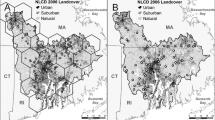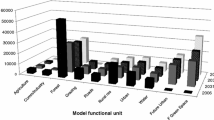Abstract
The Reference Watershed Approach (RWA) is used in TMDL development for biological and other impairments with narrative water quality criteria. The questions addressed in this research include: (1) With the RWA, how do land use classifications from different data sources (Digital Ortho-Quarter Quads (DOQQ) and National Land Cover Dataset (NLCD)) impact simulated pollutant loadings? (2) With the RWA, what is the impact of alternative water quality models (GWLF and SWAT) on pollutant loadings? (3) With the RWA, how sensitive are simulated pollutant loadings to the use of different reference watersheds? Various combinations of land use, water quality model, and reference watershed resulted in pollutant reductions that ranged from −13 to 88%. In a comparison of the use of NLCD versus DOQQ-based land use data with the GWLF model, differences in required reductions ranged from 13 to 74% for three different reference watersheds. Use of alternative water quality models with DOQQ land use data resulted in differences in required sediment reductions from −43 to 8% for the three reference watersheds. Differences in load reduction requirements were also seen when different reference watersheds were used, regardless of the water quality model or the land use source used. With DOQQ land use, required sediment reductions ranged from 18 to 88% and 37 to 82%, for the SWAT and GWLF models, respectively. These results suggest that explicit margins of safety used to account for modeling uncertainties during TMDL development may need to be substantially greater than 20% when using the reference watershed approach.


Similar content being viewed by others
References
Benham, B. L., Walker, J. L., & Yagow, G. (2003). TMDLs (Total Maximum Daily Loads) for benthic impairments. Virginia cooperative extension publication 442–556, (4 pp). Blacksburg: Virginia Tech. Available online (5/2005) at: http://www.ext.vt.edu/pubs/bse/442-556/442-556.html.
Boward, P., Teeter, L. D., Lockaby, B. G., Hurd, M. K., & Prochaska, T. P. (1999). From the mountains to the sea: The state of Maryland’s freshwater streams. (64 pp, EPA/903/R-99/023). Washington, DC: USEPA. Available online (2/2006) at: http://www.epa.gov/maia/pdf/md-streams.pdf.
Commonwealth of Virginia (2000). Total maximum daily load program, a ten year implementation plan (75 pp.). Richmond, VA: Dept. of Environmental Quality; Dept. of Conservation and Recreation; Dept of Mines, Minerals and Energy; and Dept. of Health. Available online (5/2005) at: http://www.deq.state.va.us/tmdl/reports/hb30.pdf.
Di Luzio, M., Srinivasan, R., Arnold, J. G., & Neitsch, S. L. (2002). Soil and water assessment tool. ArcView GIS interface manual: Version 2000. (346 pp, GSWRL report 02–03, BRC report 02–07) College Station, TX: Published by Texas Water Resources Institute TR-193.
ESRI (2006). ArcGIS – The complete geographic information system. Available online (2/2006) at: http://www.esri.com/software/arcgis/index.html.
Evans, B. M., Sheeder, S. A., & Lehning, D. W. (2003). A spatial technique for estimating streambank erosion based on watershed characteristics. Journal of Spatial Hydrology, 3(1). Available online (2/2006) at: http://www. spatialhydrology.com/journal/paper/erosion/erosion.pdf.
Frondorf, L. (2001). An investigation of the relationships between stream benthic macroinvertebrate assemblage conditions and their stressors. M.S. thesis (179 pp.). Blacksburg: Virginia Tech.
Haith, D. A. (1985). An event-based procedure for estimating monthly sediment yields. Transactions of the ASAE, 28(6), 1916–1920.
MapTech (2004). General standard TMDL (Total Maximum Daily Load) development for Black Creek Wise County, Virginia. Prepared By MapTech Inc., Blacksburg, VA for Virginia Department of Environmental Quality and Virginia Department of Mines, Minerals, and Energy. 172 p. Available online (2/2006) at: http://www.deq.virginia.gov/tmdl/apptmdls/tenbigrvr/blackbc.pdf.
Meyer, L. D., & Wischmeier, W. H. (1969). Mathematical simulation of the process of soil erosion by water. Transactions of the ASAE, 12(6), 754–759, 762.
Mostaghimi, S., Benham, B., Brannan, K., Dillaha, T. A., Wagner, R., Wynn, J., et al. (2003). Benthic TMDL for Stroubles Creek in Montgomery County, Virginia. Prepared for VADEQ, Virginia Department of Environmental Quality. Richmond, VA. 89 p. Available online (2/2006) at: http://www.deq.virginia.gov/tmdl/apptmdls/newrvr/stroub.pdf.
Neitsch, S. L., Arnold, J. G., Kiniry, J. R., Srinivasan, R., & Williams, J. R. (2002a). Soil and water assessment tool user’s manual: Version 2000. (472 pp, TWRI report TR-192). College Station, TX: Texas Water Resources Institute. Available online (2/2006) at: http://www.brc.tamus.edu/swat/downloads/doc/swatuserman.pdf.
Neitsch, S. L., Arnold, J. G., Kiniry, J. R., Williams, J. R., & King, K. W. (2002b). Soil and water assessment tool theoretical documentation: Version 2000. (506 pp, TWRI report TR-191). College Station, TX: Texas Water Resources Institute.Available online (2/2006) at: http://www.brc.tamus.edu/swat/downloads/doc/swat2000theory.pdf.
NRC (2001). Assessing the TMDL Approach to water quality management (109 p). Washington, D.C.: National Research Council, National Academy. Available online (2/2006) at: http://www.nap.edu/books/0309075793/html/.
USDA (1994). State Soil Geographic (STATSGO) data base data use information (113 pp, Misc. Pub. No. 1492). Washington, DC: Natural Resources Conservation Service, National Soil Survey Center, United States Department of Agriculture. Available online (2/2006) at: ftp://ftp-fc.sc.egov.usda.gov/NCGC/products/statsgo/statsgo-user-guide.pdf.
USDA (1995). Soil Survey Geographic (SSURGO) data base data use information (110 pp, Miscellaneous Publication Number 1527). Washington, DC: Natural Resources Conservation Service, National Soil Survey Center, United States Department of Agriculture. Available online (2/2006) at: http://tahoe.usgs.gov/files/ssurgo_database.pdf.
USEPA (1991). Guidance for water quality-based decisions: The TMDL process (65 pp, EPA 440/4-91-001). Washington, DC: Office of Water Regulations and Standards, U.S. Environmental Protection Agency. Available online (2/2006) at: http://www.epa.gov/OWOW/tmdl/decisions/.
USEPA (1992). Compendium of watershed-scale models for TMDL development (EPA 841-R-94-002). Washington, DC: Office of Wetlands, Oceans, and Watersheds, Office of Science and Technology, U.S. Environmental Protection Agency.
USEPA (2000). Stressor identification guidance document (228 pp, EPA 822-B-00-025). Washington, DC: Office of Water and Office of Research and Development, U.S. Environmental Protection Agency. Available online (2/2006) at: http://www.epa.gov/ost/biocriteria/stressors/ stressorid.pdf.
USEPA, U.S. Environmental Protection Agency (2002a). Clean water act. Available online (2/2006) at: http://www.epa.gov/r5water/cwa.htm.
USEPA (2002b). The twenty needs report: How research can improve the TMDL program (EPA 841-B-02-002). Washington, DC: Office of Water, U.S. Environmental Protection Agency. Available online (2/2006) at: http://www.epa.gov/owow/tmdl/20needsreport_8-02.pdf.
USEPA (2006). WATERS expert query tool. Available online (2/2006) at: http://www.epa.gov/waters/tmdl/expert_query.html.
Virginia General Assembly (1998). Legislative information system. Virginia Administrative Code. Available online (5/2005) at: http://leg1.state.va.us/000/reg/TOC.HTM.
Wagner, R. C. (2004). An examination of the reference watershed approach for TMDLs with benthic impairments. M.S. thesis (110 p). Blacksburg: Virginia Tech.
Yagow G. (2004). Using GWLF for development of “reference watershed approach” TMDLs. Paper no. 042262. 2004 ASAE/CSAE annual international meeting. July 31–August 4, 2004. Ontario, Canada. ASAE: St. Joseph, MI. 10 pp.
Acknowledgements
The authors wish to thank the Center for TMDL and Watershed Studies at Virginia Tech for technical and financial support, the Virginia Department of Conservation and Recreation for funding, and the Virginia Department of Environmental Quality for guidance throughout the Stroubles Creek TMDL development process.
Author information
Authors and Affiliations
Corresponding author
Rights and permissions
About this article
Cite this article
Wagner, R.C., Dillaha, T.A. & Yagow, G. An assessment of the reference watershed approach for TMDLs with biological impairments. Water Air Soil Pollut 181, 341–354 (2007). https://doi.org/10.1007/s11270-006-9306-8
Received:
Accepted:
Published:
Issue Date:
DOI: https://doi.org/10.1007/s11270-006-9306-8




